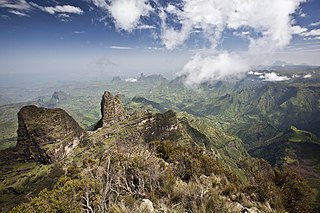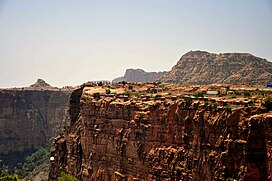
The Kingdom of Saudi Arabia is a country situated in West Asia, the largest country on the Arabian Peninsula, bordering the Persian Gulf and the Red Sea. Its extensive coastlines provide great leverage on shipping through the Persian Gulf and the Suez Canal. The kingdom occupies 80% of the Arabian Peninsula. Most of the country's boundaries with the United Arab Emirates (UAE), Oman, and the Republic of Yemen are undefined, so the exact size of the country remains unknown. The Saudi government estimate is at 2,217,949 square kilometres, while other reputable estimates vary between 2,149,690 and 2,240,000 sq. kilometres. Less than 7% of the total area is suitable for cultivation, and in the early 1960s, population distribution varied greatly among the towns of the eastern and western coastal areas, the densely populated interior oases, and the vast, almost empty deserts.

The Arabian Desert is a vast desert wilderness in West Asia that occupies almost the entire Arabian Peninsula with an area of 2,330,000 square kilometers (900,000 sq mi). It stretches from Yemen to the Persian Gulf and Oman to Jordan and Iraq. It is the fifth largest desert in the world and the largest in Asia. At its center is Ar-Rub' al-Khali, one of the largest continuous bodies of sand in the world. It is an extension of the Sahara Desert.

The Ethiopian Highlands is a rugged mass of mountains in Ethiopia in Northeast Africa. It forms the largest continuous area of its elevation in the continent, with little of its surface falling below 1,500 m (4,900 ft), while the summits reach heights of up to 4,550 m (14,930 ft). It is sometimes called the "Roof of Africa" due to its height and large area. It is the only country in the region with such a high elevated surface. This elevated surface is bisected diagonally by the Great East African Rift System which extends from Syria to Mozambique across the East African Lakes. Most of the Ethiopian Highlands are part of central and northern Ethiopia, and its northernmost portion reaches into Eritrea.

The Eastern Mediterranean conifer-sclerophyllous-forests, also known as the Eastern Mediterranean conifer-forests, is an ecoregion in the eastern Mediterranean Basin. It covers portions of Turkey, Syria, Iraq, Lebanon, Israel, Palestinian territories, Jordan, and Saudi Arabia.

The Yemen serin is a species of finch in the family Fringillidae. It is found in Oman, Saudi Arabia, and Yemen.

The Sarawat Mountains, also known as the Sarat in singular case, is a part of the Hijaz Mountains in the western part of the Arabian Peninsula. In a broad sense, it runs parallel to the eastern coast of the Red Sea, and thus encompasses the mountains of Fifa', 'Asir and Taif. In a narrow sense, the Sarawat start in Taif city in Saudi Arabia, and extend to the Gulf of Aden in the south, running along the entire western coast of Yemen, in what used to be North Yemen, and extend eastwards into part of what used to be South Yemen, thus running parallel to the Gulf of Aden.

The Mediterranean woodlands and forests is an ecoregion in the coastal plains, hills, and mountains bordering the Mediterranean Sea and Atlantic Ocean in North Africa. It has a Mediterranean climate, and is in the Mediterranean forests, woodlands, and scrub biome.

The Arabian Peninsula coastal fog desert, also known as the Southwestern Arabian coastal xeric scrub, is desert ecoregion on the southern coasts of the Arabian Peninsula, which experiences thick fogs where visibility may be reduced to 10 metres (33 ft). It is classed as an Afrotropical fog desert

The Asir Mountains is a mountainous region in southwestern Saudi Arabia running parallel to the Red Sea. It comprises areas in the Region of 'Asir, but generally, it also includes areas near the border with Yemen. The mountains cover approximately 100,000 square kilometres (40,000 sq mi) and consists of mountains, plains, and valleys of the Arabian highlands. Sensu lato, they are part of the Sarawat Mountains, defining the latter as the mountain range which runs parallel to the Tihamah throughout the western portion of the Arabian Peninsula, particularly the western parts of Saudi Arabia and Yemen.

The Ethiopian montane grasslands and woodlands is a montane grasslands and shrublands ecoregion in Ethiopia. It occupies the middle elevations of the Ethiopian Highlands, between the high-altitude Ethiopian montane moorlands and the lower-elevation Ethiopian montane forests.

The Ethiopian montane forests is a tropical moist broadleaf forest ecoregion in Ethiopia. It covers the southwestern and southeastern portions of the Ethiopian Highlands. The ecoregion includes distinctive Afromontane evergreen forests. The ecoregion's biodiversity is threatened by deforestation, conversion to agriculture, and overgrazing.
The wildlife of Yemen is substantial and varied. Yemen is a large country in the southern half of the Arabian Peninsula with several geographic regions, each with a diversity of plants and animals adapted to their own particular habitats. As well as high mountains and deserts, there is a coastal plain and long coastline. The country has links with Europe and Asia, and the continent of Africa is close at hand. The flora and fauna have influences from all these regions and the country also serves as a staging post for migratory birds.

The wildlife of Saudi Arabia is substantial and varied. Saudi Arabia is a very large country forming the biggest part of the Arabian Peninsula. It has several geographic regions, each with a diversity of plants and animals adapted to their own particular habitats. The country has several extensive mountain ranges, deserts, highlands, steppes, hills, wadis, volcanic areas, lakes and over 1300 islands. The Saudi Arabian coastline has a combined length of 2,640 km (1,640 mi) and consists of the Gulf of Aqaba and the Red Sea to the west while a shorter eastern coastline can be found along the Persian Gulf.
The Wadi Turabah Nature Reserve is a protected area in the Makkah Region of southwestern Saudi Arabia. It is situated about 150 km (93 mi) south-east of Ta'if and 80 km (50 mi) north of al Bahah, sandwiched between the road between Taif and al Bahah and the road running along the escarpment between Banu Sa'ad and al Bahah. It adjoins the Jabal Ibrahim/Wadi Buwwah Protected Area, Jabal Ibrahim being a granite mountain rising about 1,000 m (3,300 ft) above the surrounding rocky hills. Wadi Turabah and Jabal Ibrahim have a total area of around 42,000 hectares and the elevation rises from 1,600 m (5,249 ft) to 2,604 m (8,543 ft) at the summit of Jabal Ibrahim.

The Somali montane xeric shrublands is a desert and xeric scrubland ecoregion in Somalia. The ecoregion lies in the rugged Karkaar Mountains, which run parallel and close to Somalia's northern coast on the Gulf of Aden, and follows coast from Cape Guardafui south to Eyl on the Arabian Sea.

The Southwestern Arabian foothills savanna, also known as the Southwestern Arabian Escarpment shrublands and woodlands, is a desert and xeric shrubland ecoregion of the southern Arabian Peninsula, covering portions of Saudi Arabia, Yemen, and Oman.

The South Arabian fog woodlands, shrublands, and dune is an ecoregion in Oman and Yemen. The fog woodlands lie on mountainsides which slope southeastwards towards the Arabian Sea. The mountains intercept moisture-bearing winds from the Arabian Sea, creating orographic precipitation and frequent fogs that sustain unique woodlands and shrublands in a desert region.

The Mediterranean High Atlas juniper steppe is a montane grasslands and shrublands ecoregion in Morocco. It extends along the High Atlas range of northwestern Africa's Atlas Mountains.

Al Hajar montane woodlands is a temperate grasslands, savannas and shrublands ecoregion in the Hajar Mountains of the eastern part of the Arabian Peninsula, which extends across portions of Oman and the U.A.E.

Asir National Park is a national park in Saudi Arabia's Asir region. It was established in 1981.



















